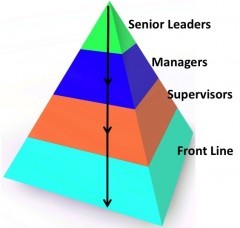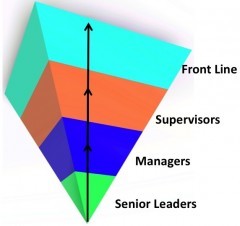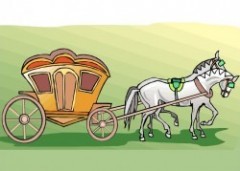 What’s your view of leadership? If you’re like most people, you have an underlying belief that leaders should be out in front of the line, leading the way.
What’s your view of leadership? If you’re like most people, you have an underlying belief that leaders should be out in front of the line, leading the way.
The Hierarchical View of Leadership
In the traditional, hierarchical view, senior leaders are at the top of the organization and ensure the organization fulfills its mission effectively.
There are differing views about how leaders should behave – the best leadership style. For example, you might think leaders should be directive or participative or both depending on the situation.
Although Steve Jobs, Hillary Clinton, Ronald Reagan, Sheryl Sandberg, and Howard Schultz have very different leadership styles, they all have one important thing in common – their role as a leader is to stand in front of their organization and lead the way forward. They are at the top of the pyramid.
Some people see the Inverted Pyramid as an alternative. In this view of leadership, the pyramid is turned upside down, and leaders see themselves at the bottom of the pyramid, serving the people.
 Leaders “serve” the people who report to them by providing what they need. The front line, the people who are in direct contact with customers, are “empowered” by the senior leaders to make many decisions that affect customers. Leaders who subscribe to this view of leadership include Herb Kelleher, Dan Cathy and Sally Jewell.
Leaders “serve” the people who report to them by providing what they need. The front line, the people who are in direct contact with customers, are “empowered” by the senior leaders to make many decisions that affect customers. Leaders who subscribe to this view of leadership include Herb Kelleher, Dan Cathy and Sally Jewell.
Leaders do not give away their power. Leadership is more like parents of teenagers, allowing freedom with oversight. It might be a loving style, but leaders still have responsibility for the people they manage.
This is still a pyramid, with a top and bottom, and with a clear line of reporting – a hierarchical view of leadership where those in control bestow power on others.
Instead of Inverting the Pyramid, Topple It 
The problem is the hierarchical view of leadership is not nearly as effective as we would like to believe.
Too many people with the designated title of “leader” are not leading at all. Often the real leadership that occurs has nothing to do with the pyramid, whether it is right side up or upside down, because the people who make the most significant impact are hidden somewhere within the pyramid.
Leadership Is an Emergent Quality, Not a Role
There’s another way to view leadership – one we are all familiar with – where leadership is a quality that emerges when needed.
Anyone who has been a member of a high performing team knows that leadership flows among team members, depending on who has the needed skills, knowledge or attitude in the moment, and that at various times each team member significantly influences the team. A team that is dependent on one person will never fulfill its full potential.
Over the years, I have asked hundreds of people to list the top five qualities of a high performance team, and “shared leadership” is always on the list.
Perhaps you agree emergent leadership can work for a team, but think it’s not possible for a complex organization. Actually, the idea of a non-hierarchical company is not far-fetched at all.
In 1970 Alvin Toffler introduced the concept of adhocracy, where “all members of an organization have the authority within their areas of specialization, and in coordination with other members, to make decisions and to take actions affecting the future of the organization.” This idea was further developed by Henry Mintzberg and others.
Morning Star, a highly successful manufacturing company, was founded in 1970. Still thriving today, it was described by Gary Hamel in First, Let’s Fire All the Managers (Harvard Business Review, 2011).
In Who’s the Boss? There Isn’t One, Rachel Silverman describes Gore and Valve (Wall Street Journal). And there are many more examples emerging as young entrepreneurs are discovering the control-oriented models stifle creativity and innovation.
In Making Sense of Zappos and Holocracy, Steve Denning provides an analysis of Zappos recent decision to get rid of managers. He demonstrates that “holocracy” will not lead to chaos, but unfortunately equates structure with hierarchy.
Hierarchy depends on the use of power to control outcomes, and the controls extend to the people within the organization. Even when the power is used benevolently, it is still a patriarchal view, and so the workers are by extension “children,” not adults. A shared vision and supporting structure are a far more effective alternative to hierarchical power.
Non-hierarchical Leadership Is Not a New Idea

The emergent view of leadership can be traced to the 4th century BCE where Lao Tzu said, “When the best leader’s work is done the people say, ‘We did it ourselves.'”
The real nature of leadership can be such a light touch that it might not be noticed.
This 18th century tale illuminates leadership as a vehicle, not a role:
A story is told that one day as the great Rabbi Elimelech of Lizhensk was riding in a carriage, he noticed a throng of people following.
He asked his coachman, “Why are all the people trailing behind?”
The coachman explained that the people wanted to follow after wisdom and holiness.
Elimelech decided that this was a good idea — the people were doing the right thing.
So he got out and joined the people following the empty carriage.
IMPORTANT: Lessons for Leaders Within the Pyramid
Most of us work in hierarchical organizations that are not going to fundamentally change. But it’s not “all or nothing.” Even within a traditional organization, we can move in this direction at a personal level by 1) holding a vision of leadership as a function and not a role, 2) by aligning our intention consistently with our actions and 3) by supporting leadership when it does emerge.
Following these principles can make a big difference for yourself and your team:
1. Don’t confuse leadership with the carriage, the vehicle. You are an instrument, not your role.
2. Great leaders draw their understanding of what’s happening and what’s needed from the people who follow them.
3. Be willing to follow. Leadership is a dance, not a parade.
4. Challenge your perceptions of leadership. Notice and support emergent leadership when it occurs.
5. Remember your greatest source of influence is your character, not your role or position.













My last team was the best example of this I’ve ever experienced. There was constant support and leveraging of unique skill sets. It’s beautiful to see a team get to that level. An important point here is that the leaders with the big titles and position power really influence whether the environment is healthy soil for such leaders to grow and emerge.
Thanks for sharing your experience, Karin. Your experience is important because it takes this out of the realm of theory and shows what’s really possible. I agree that the environment makes a big difference. But I would also mention that if a leader is intentional, it is possible to serve as a buffer in a non-supportive environment. Once when hiking in Bryce Canyon, I noticed a small tree growing from a crack in a wall of rocks, and I was struck by how life can emerge in unlikely places. Supporting the natural emergence of leadership begins with recognizing and appreciating it when it does occur.
Lesson #2 really resonates with me: if you want to draw inspiration from your people, you have to be “inspireable” (maybe another word for open-minded). I have to consciously diminish my role (with all the badges, medals, etc), trust that they have good heads on their shoulders and our best interests at heart, and really listen to what they have to say. Definitely not the traditional model fof a fire department!
Great point about the need to step out from behind your formal role and make real connection by listening with respect. This needs to be done consciously and intentionally because others are often intimated by formal authority, and especially by those they respect and admire, and will otherwise naturally hold back. Definitely not the traditional role for a fire department, but I bet it makes a big difference. Thanks for sharing your own lessons, Dave.
Jesse thank you for this great article. As the Lean Enterprise Manager I find that when I am “Leading” (I use the term loosely) teams to continuous improvement facilitation works wonders as emergent leaders take the reigns and run with them. Being able to pocket your ego and allow others to take the lead is difficult for some. I have always believed that leaders get things done through others and sometimes that means letting others take the lead.
You raise an important point, Woody. None of this works unless you pocket your ego. I’d add that as lesson #6. Thanks for sharing your own experience and reinforcing that these ideas can be put into practice.
Jesse,
This post covers a lot of ground (and does so thoughtfully). I agree with you from a philosophical standpoint, but find myself being cynical: how many people can really operate in this environment? Will leaders at the either end of the pyramid ever be willing to relinquish that measure of control?
I’m so glad to see Karin’s real-life commentary, as it gives me hope that more and more teams can topple the pyramid.
I appreciate your raising these concerns, Jennifer, which I’m sure others share as well. To the question of whether existing organizations can completely make this shift, my response is, “I don’t know.”
The article about Morning Star is fascinating. One of the things they have observed at Morning Star is that of the hundreds of executives who have visited them over the years, none returned to their organization and implemented this kind of change. They postulate this is because a few leaders cannot navigate the complexity within a hierarchical organization to get other leaders to willingly give up their power. It will be interesting to see what happens at Zappos as they make this shift. In his article, Denning says he thinks they might be successful because they are already a Lean organization.
What I want to stress is that even within a hierarchical organization, we can move in this direction at a personal level by 1) holding a vision of leadership as a function and not a role, 2) by aligning this intention consistently with our own actions and 3) by supporting leadership when it emerges.
Jesse, so well put. My two favorite ideas -” Instead of inverting, topple it. ” Leadership is a dance, not a parade.” Thank you.
Thank you, Fay!
Jesse,
I could not wait to have a few minutes to really pause to read and reflect on this post! …It was totally worth the wait!
I especially loved the 5 Lessons for Leaders in the Pyrmid and will be spending more time diving into the links you shared and pondering!
So glad to hear you’re digging into this, Chery. At its best, the typical parental approach to leadership is nurturing, but is not fully empowering. It’s just hard for us to imagine a different model because the parental view is completely ingrained into our experience in every institution we encounter from the time we are children. And when we do experience a different form, we assume it is an exception. The articles show places where a non-hierarchical approach to leadership works. I hope to spark more thinking about what’s really possible, not only for creating different kinds of organizations, but also for individuals who live and work in traditional organizations.
Thank you, clear article.
I think the important thing is that you feed an inverted pyramid delegation or empowerment in organizations, with an integrator and situational leadership.
Also, in my opinion, everything is based on the leader’s ability to build a team of leaders in sustainability.
From experience, I think the greatest satisfaction of a leader is to see how their employees exercise leadership and develop leaders among their subordinates, in addition to support emerging leaders in their training.
Luis Miguel Manene
Jesse, you are right about leaders emerging. And, there are also times when there MUST be a “top of the pyramid” to drive the carriage. A very brave example of this is Mary Barras, CEO of GM. She inherited a mess. She is not, however, throwing anyone under the “carriage” until she finds out information from a third party investigation. She is courageous enough to take a stand and say “we will fix this”. You can have many emerging leaders, but in times of crisis– there must be a point person.
Hi Eileen, I agree that traditional, hierarchical organizations require a strong leader at the top of the pyramid to turn things around during crisis. Your example of Mary Barras is an excellent one. Louis Gertsner, Jr at IBM is another classic example. But there are also situations where in the midst of crisis the designated leader was ineffective and a heroic leader emerged – even in the military, one of the most hierarchical organizations. (Think of some of your favorite movies.)
Thanks for another insightful post, Jesse.
One of the best examples of this style in my own career was when I led an IT project team (as a non-techie) for a major client. The project was large, complex, and technically challenging within a highly political environment. None of us could do the job of the other, though all of our skills were needed to execute. We referred to ourselves as the three-legged stool, and though I was captain of the ship, we all knew our roles and that we were in this together. It was a beautiful example of teamwork, not only from the perspective of skills, but also values, which you touch on in your last point. As trust and respect deepened, we were truly able to achieve much more than any one of us could have alone.
Great example, Sharon. Thanks so much for describing your experience and providing a view of what emergent leadership can look like.. I think it might be more common for these kinds of teams to emerge in matrix environments where work is accomplished through cross-functional projects.
Fantastic post. I’d add two thoughts for the leader who chooses the non-hierarchical model. You also have to apply it to customers and other stakeholders such as suppliers and partners. There may be times in the life of organization when people need to be told what to do – how the leader tells them matters.
Good point, Alan. No matter what the model is, the only thing that makes sense is a whole systems view. I’ve always been mystified how customers get left out of the equation in most organizations – seen as outside the system. And yet, the reason an organization exists is to provide a service for the customer. The same thing with other stakeholders – without them, the organization would be unable to deliver on its mission.
Jesse wanted to let you know that this post “needed” a second round of posting to my digital footprint.
Happy to share again my friend, very well written and communicated. Lead on LEADER!
Thank you, Kenneth. 🙂 So glad you found this viewpoint worth sharing.
Jesse, thank you for a thoughtful article. Your responses to the comments definitely add to the thinking as well. I was struck by Jennifer Miller’s question about whether leaders will be able to relinquish control and I appreciate your discussion of the case studies about Morning Star and Zappos. I have an additional question – if leaders find it difficult to change to this new working environment, how about employees? Are we not, most of us, habituated from birth to being part of a hierarchy, be it family, school, or whatever? How prepared are individuals to work in looser, less hierarchical organizations?
Hi Tarik, I really appreciate your questions, as I am sure they reflect the thoughts of many, and I am glad for an opportunity to respond.
First, I want to emphasize that lack of hierarchy does not mean lack of structure. Without structure, it is impossible for a group to coordinate efforts or make intelligent decisions. However, in this case, the structure is provide through clarity of vision, values, goals and processes for communication and decision-making, not by an individual whose role is to be “in charge” of others. When someone drops the ball or act irresponsibly, those who are affected will respond naturally. That’s what I mean about leadership emerging as it is needed.
My second point is that children need adults to protect them. Up to a certain age, a benevolent hierarchy (parental figures) is important. But grown adults don’t need to be treated like children. Research has shown time and again that the more people have control over their work and the more involved they are in decisions that affect them, the greater their understanding of the best way to accomplish their work and the deeper their commitment. Considering the appalling number of disengaged employees in current hierarchical organizations, I question how well prepared adults really are to live and work in hierarchical organizations. It’s true that’s all most of us have ever known, but that’s also why many animals that have grown up in cages, don’t stray far from their cage if the door is left open.
Great points, Jesse. Do you think there’s an optimal size that such non-hierarchical structures can operate at? Robin Dunbar suggests we can only “know” 150 really well. That’s also been the size of many military units throughout history, starting with the Roman cohorts. Then again, some organizations keep operational units to below 1,000 employees. Does size impact our ability to work well in this new, looser way?
Excellent question, Tarik. I believe size is a factor. Morning Star has 400 full-time and about 2,300 season workers. Gore is a large multi-billion dollar company, but they limit the number of employees at every facility to 200. What’s important is that each self-managing unit has the resources they need. This article speaks more to your question: Who’s in Charge Here?
Thanks Jesse. I’ve long been fascinated by Gore. So many have tried to emulate their management approach and failed, yet their success continues! By the way, I couldn’t get that link to work.
Hi Tarik,
No one has been successful at emulating Morning Star, either. Each organization is unique and rather than trying to replicate, what is needed is to use the principles to design the approach that works for your own organization.
p.s. Not sure why the link didn’t work for you. It is working, so please try it again. It’s a great article.
Nice post. Emergent leadership, adhocracy certainly has its place and works. Two things to watch out for in certain circumstances:
(1) which ‘leader’ takes responsibility in events like overstepping a legal boundary, negative environmental impact, lost customer ….?
(2) the necessity of ensuring that all leaders are operating off the same virtues – base …
Good points, Graham. Generally #2 will take care of #1 (assuming everyone in the organization is a “leader.”) When the vision and values are deeply held and widely shared, people support each other in making good decisions and getting back on track when they make a mistake. The other piece that needs to be in place is for relevant information to be readily available. (e.g people need to understand the budget in order to make fiscally sound decisions; they need to understand the laws to make legally responsible decisions, etc.)
In a toppled set-up (if that makes any sense!) communication via the sharing of stories is key – and this of course also applies during the ‘toppling process’ – I love this from Ben Okri: Stories are the secret reservoirs of values. Change the stories nations and individuals live by and tell themselves, and you change individuals and nations.
The importance of stories cannot be under-rated. Thanks for sharing this, Graham!
Very inspiring and motivative. But am confused of leadership being a function and not a role. If more light could be thrown on it i would be happy.
I use the term “role” to refer to someone with the title of leader in their organization. I use the term “function” to refer to the act of leadership – influencing others to take a certain action. It is possible that someone might have the title of leader (which is their role) but not provide any real leadership for their team. Someone on the team might not have the title of leader, but others respect and listen to that person. That person functions as a leader, even though they don’t have an official title.